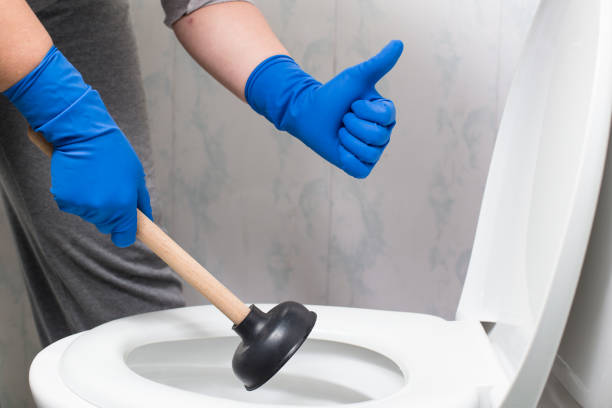Blocked toilets are a common household problem that can cause inconvenience and discomfort. Most of us don’t even want to deal with it. However, sometimes you have no choice but to put on your plumbing hat.
While a plumber may be necessary in some cases, several DIY fixes can also clear the blockage and get your toilet working again. Not only will these solutions save you money, but they can also help you avoid the hassle of waiting for a professional to arrive.
This article discusses 7 effective DIY fixes for blocked toilets in Geelong. Whether it is a minor blockage or a more serious issue, these tips will help you resolve the problem and get your toilet back to normal.
1. Take Out the Plunger
A plunger is a common tool for fixing a clogged toilet. It creates suction that helps to dislodge the blockage and push it down the drain. Many of you will have this tool at home; if you don’t, get one immediately. It is a lifesaver!
To use a plunger, first, make sure there is enough water in the bowl to cover the plunger. Then, place the plunger over the drain and push it down gently, creating a seal. Next, use an up-and-down motion to force air into the drain and create suction.
Continue plunging until the blockage clears. If the clog persists, it may require further intervention or the help of a professional plumber.
2. Pour Hot Water
Pouring hot water into the toilet bowl can also help to loosen and flush away any blockage. The hot water can help break up any material clogging the toilet and allow it to flow through the pipes more easily.
To use this method, heat a pot of water on the stove until it is just below boiling point. Carefully pour the hot water into the toilet bowl and let it sit for a few minutes. Then, flush the toilet to see if the blockage has been cleared. If not, repeat the process a few times until the blockage clears completely.
3. Squeeze in Some Dish Soap
Dish soap is another useful household item that you can use to unclog a blocked toilet. Pour a generous amount of dish soap into the toilet bowl, let it sit for a few minutes, and then pour hot water.
The dish soap will act as a lubricant and help to break up the blockage, while the hot water will help to dissolve any grease or debris that may be causing the problem.
Remember that dish soap is only a temporary solution, not a permanent fix for a blocked toilet. If the problem persists, we recommend calling a professional plumber to avoid further damage or complications.
4. Use a Toilet Auger
A toilet auger, also known as a closet auger, is a plumbing tool designed specifically for clearing clogs in toilets. It features a long, flexible cable with a coiled end that can navigate through the curves of the toilet trap.
You simply insert the auger into the toilet bowl and crank it to manoeuvre the cable down the drain until it encounters the blockage. Once you secure the auger to the clog, turn and break it apart, allowing the water to flow freely through the drain.
Using a toilet auger can be an effective solution for stubborn clogs that neither a plunger nor home remedies could dislodge.
5. Wire Coat Hanger
A wire coat hanger can also become a toilet-unclogging tool if you know how to use it. It can be as effective as any other method on this list.
Straighten the hanger and create a hook at one end, then insert it into the toilet bowl and try to dislodge the blockage. But be careful not to scratch or damage the porcelain of the toilet bowl.
You can easily clear the clog and get the toilet back to working normally with just a few attempts. This method can be effective for simple blockages caused by foreign objects or debris. However, it may not be effective for more serious blockages, such as those caused by tree roots or a collapsed pipe. In those cases, your best bet would be to call a professional plumber.
6. Concoct a Natural Declogger
Our kitchen has many natural ingredients that can do great at unclogging a toilet without needing any chemical solution. For example, baking soda and vinegar are the go-to solutions for blocked toilets in Geelong.
Baking soda and vinegar are two household items that are inexpensive and eco-friendly. To create this solution, start by pouring a cup of baking soda into the toilet bowl, followed by two cups of vinegar. You could even make the mixture first and then pour it.
Let the mixture sit for several minutes to allow the chemical reaction to occur, then flush the toilet. The mixture can help dissolve the blockage and break it up, making it easier to flush away. Repeat the process if necessary, but be careful not to use too much baking soda or vinegar, as they can cause the toilet to overflow.
Final Thoughts
A blocked toilet can be a stressful and unpleasant experience, but there are several DIY fixes that you can try before calling a professional plumber. From using a plunger and pouring hot water to using a toilet auger and wire coat hanger, these methods are effective and easy to perform with the right tools and techniques.
However, if the blockage is persistent or there is a serious underlying issue, it is important to hire a licensed and experienced plumber to ensure that the problem is resolved safely and effectively. With these tips, you can confidently tackle a blocked toilet and keep your plumbing system running smoothly.
Your Local Plumbing has vast knowledge in all things plumbing related. Their experts have experience, skill, and a reputation for being one of Australia’s best. Check out their services and give them a chance to help you.
